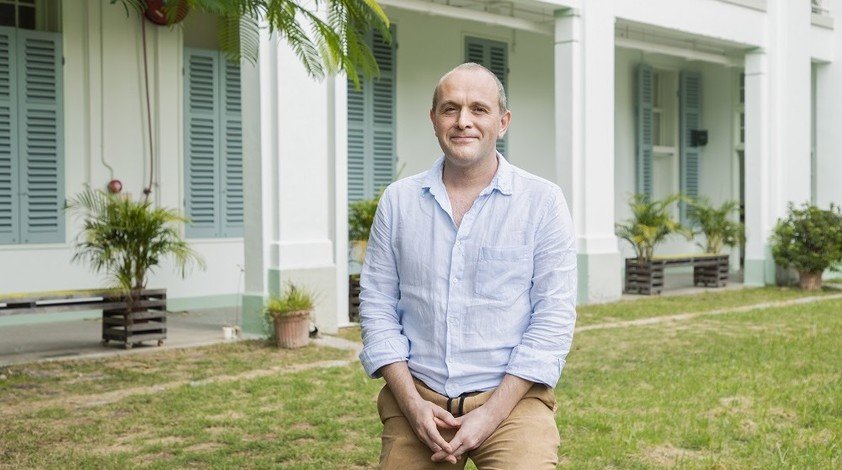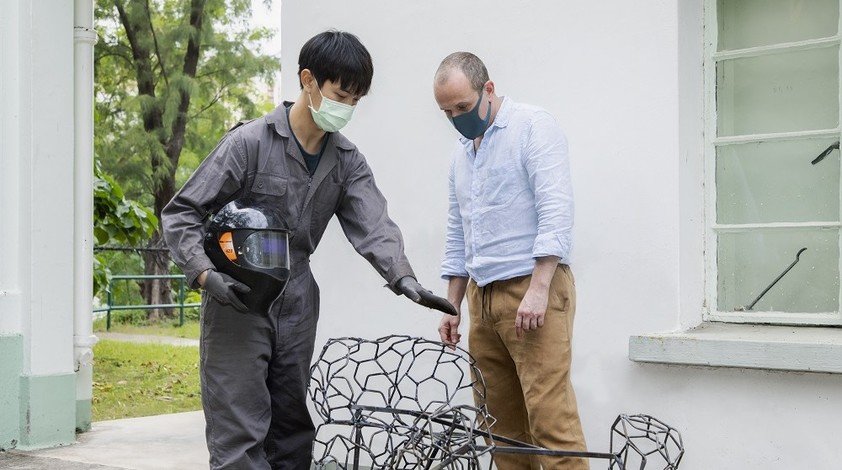discover hkbu
The art of science
30 Nov 2021
While humble diagrams may not be the first thing we associate with art, according to Dr Michael Whittle, they provide a unique area of overlap between the seemingly disparate worlds of art and science.
"Diagrams provide a way for us to visualise science," says Dr Whittle, Research Assistant Professor of the Academy of Visual Arts (AVA). As a British artist with a background in biomedicine, he specialises in diagrammatology, the study of diagrams, and he often uses scientific diagrams as a starting point for his artistic projects.
Through a wide variety of artworks, ranging from drawings and sculptures to installations, he has developed creative ways to reframe scientific discoveries in an artistic context, merging the subjectivity of art with the objectivity of science.
Bridging art and science
For Dr Whittle, the notion of exploring the areas where art and science interact grew out of his early interest in both fields. Influenced by his father, who is a designer, and his mother, who works as a nurse, Dr Whittle has always been curious about biology, and he also nurtured a passion for drawing as a child.
Although he qualified as a biomedical scientist, his love for art did not fade. "As I spent time working in a lab, my field of research became increasingly narrow, and I was much more interested in understanding the bigger picture when it comes to science. I found that as an artist, I'm free to move between different disciplines," says Dr Whittle of his decision to study Fine Art. "And as much as I love science and was in awe of what we've discovered, scientific papers have to be objective. But an artist has the permission to create works that express that sense of wonder and awe that we get from science."
His artworks draw inspiration from images, ideas and data found in scientific research papers, as well as discussions with scientists about the concepts and motivations underlying their studies. His installation Perpetual Motion, which was exhibited in Hong Kong this May, is one of the pieces that represents important scientific discoveries as works of art. "This project grew out of an idea I had while I was in quarantine for three weeks. I wanted to create a piece about movement and motion, so I started researching how contemporary science explores these concepts," says Dr Whittle.
The installation features a specially designed carpet that is based on the firing patterns of grid cells, and the markings on the carpet mirror elements of the microscopic neuronal processes that occur within the brains of the viewers when they walk across it. Above the carpet circulates a mobile sculpture of pie charts, which contain worldwide genetic data from female populations from 500 years ago. "The installation contrasts two important scientific discoveries related to movement. Viewers can move underneath this map of a bigger movement that occurred over a longer period of time, while they're also moving across a diagram that shows movement and location at a very different scale of time and space," says Dr Whittle.
His recent artworks at HKBU include Noctis Labyrinthus, Labyrinth of the night, an installation that adapts the images of Mars acquired by NASA's Mars Exploration Program. Modelled directly from satellite scans of canyons on the surface of the planet, the piece proposes a fictional Martian city whose architectural plans are based upon the maze-like diagrams of a molecule called the ribosome. "The ribosome is found in all life on earth, including humans. The idea was to use this ancient pattern as a blueprint for our first extraterrestrial colony, as a gesture to celebrate the potential spread of life on earth out in to the solar system," says Dr Whittle. The artwork is featured in FIRST CITYA 2021, an international art exchange programme and exhibition organised by Ms Janet Fong, Research Assistant Professor of AVA, that took place between September and November this year.
Finding poetry in science
As a member of the University's Augmented Creativity Lab, Dr Whittle is leading a number of art and science projects, including an interdisciplinary collaboration with researchers from the Department of Computer Science. In a project entitled "Abstract Poetry", the team has been attempting to use Generative Adversarial Networks to create poetry from the abstracts of scientific papers.
According to Dr Whittle, using machine learning to turn the words in abstracts into contemporary poems is one particularly challenging aspect of the project. "I find that many scientific projects are based upon beautiful and profound ideas, but to train the computer to approach the abstracts in the same way is more complicated," he says, adding that it is important to experiment and explore the new scope of art-tech research. He also appreciates the opportunity for meaningful collaboration between the departments. "Computer scientists work in a very different way to artists. It's great to see how these different disciplines work together."
The concept of finding poetry within science comes naturally to Dr Whittle in his own studio practice. Indeed, one previous project was connected to a scientific study that aimed to map the origins of the human language. "The ambition of that kind of research is incredibly romantic, and I find it philosophically inspiring and very poetic. When I try to develop science into art, I always look for the poetry in the project," he says.

